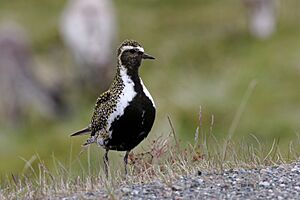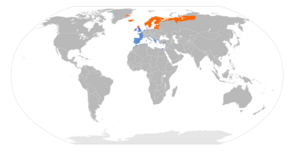European golden plover facts for kids
Quick facts for kids European golden plover |
|
|---|---|
 |
|
| An adult European golden plover during breeding season | |
| Conservation status | |
| Scientific classification | |
| Genus: |
Pluvialis
|
| Species: |
apricaria
|
 |
|
| Synonyms | |
|
|
The European golden plover (Pluvialis apricaria) is a medium-sized bird that belongs to the plover family. People also call it the European golden-plover or Eurasian golden plover. In Europe, it's often just known as the golden plover.
This bird looks a lot like two other golden plovers: the American golden plover and the Pacific golden plover. However, the European golden plover is a bit bigger and stronger. The other two are smaller and have longer legs. A key difference is their "armpit" feathers, called axillary feathers. The European golden plover has white ones, while the American and Pacific plovers have grey ones. You can usually only see these feathers when the bird is flying.
Contents
About the European Golden Plover
The European golden plover is a fairly strong bird. Its wings are only a little bit longer than its tail. The easiest way to spot this bird is by a white, S-shaped stripe. This stripe goes from its forehead all the way down to its sides, called flanks.
Where They Live and Travel
European golden plovers usually make their nests and raise their young in the Arctic tundra. This is a cold, treeless area in the far north. They also live in other northern parts of Europe and Asia, known as the palearctic region. You can find them as far west as Iceland and as far east as central Siberia.
When winter comes, these birds gather in large groups. They fly to warmer, open areas like farms, freshly ploughed fields, and short grassy meadows. They travel from Europe all the way to North Africa.
In the United Kingdom, young golden plover chicks eat crane flies. In Sweden, they prefer to eat march flies.
Sounds and Flight
The European golden plover has a simple, sad-sounding call. It makes a single "tuu" sound that goes down slightly in pitch.
When it flies, the European golden plover moves its wings quickly and powerfully. It has a strong, steady flight.
Golden Plovers in Culture
Folklore in Iceland
The European golden plover spends its summers in Iceland. In old Icelandic stories, people believe that spring has truly arrived when they see the first plover. The news in Iceland always reports when the first plover is spotted. For example, in 2017, the first one was seen on March 27. In 2020, it was spotted even earlier, on March 16.
How Guinness World Records Started
The famous Guinness World Records book has a surprising connection to the European golden plover!
In 1951, a man named Sir Hugh Beaver was the boss of the Guinness Breweries. He went hunting in Ireland and missed a shot at a European golden plover. This led to a big discussion about which game bird in Europe was the fastest: the golden plover or the red grouse. Sir Hugh thought the golden plover was faster.
That evening, he realized he couldn't find any book to prove who was right. He thought, "There must be many other questions like this that people argue about in pubs every night!" He realized a book that answered these kinds of record-breaking questions would be very popular.
Sir Hugh heard about two brothers, Norris and Ross McWhirter, who ran a fact-checking business in London. He met them and was very impressed by how much they knew. He asked them to create the book. The first Guinness World Records book was published and quickly became a huge bestseller!
Conservation Status
The European golden plover is a species protected by an important agreement. This agreement is called the Agreement on the Conservation of African-Eurasian Migratory Waterbirds (AEWA). It helps protect birds that travel long distances between Africa, Europe, and Asia.
Images for kids
-
A European golden plover in Iceland.





